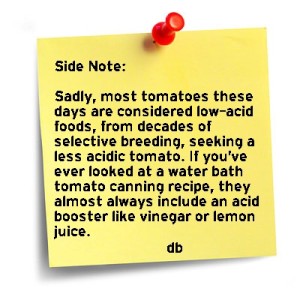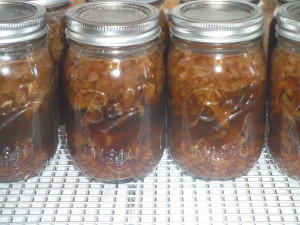A few weeks ago, I received an email from Jeff, The Berky Guy over at Directive21, in regards to an impending price increase in canned beef. It appears that due to a shortage from a variety of reasons, we are about to get squeezed again as consumers.
Over the last couple of years, with the costs of grain going up, we’ve been seeing a lot of cattle being shipped to market. This has driven the price of beef down. Now with much of the cattle supply having dried up, so we are seeing beef prices rebound. Sadly, the days of the $6/lb ribeyes are almost over….
So I thought I’d revisit pressure canning in order to show how I make a long term storable for tighter times, or simply as a way to put aside food at today’s prices for an uncertain tomorrow.
In a previous article, I wrote about the cold pack process, my favorite way to preserve meat. It is simple, fast, and efficient, yielding a mighty fine product that is at least as tasty as any off the shelf product. It also has the added benefit of you controlling what you are putting into it.
Water Bath vs Pressure Canning
A bit of the science behind canning.
There are two types of canning, water bath canning and pressure canning.
 Water bath canning is good for high acid foods like jams, jellies, and pickles.
Water bath canning is good for high acid foods like jams, jellies, and pickles.
Pressure canning is for low acid foods, like green beans, collards, fish and animal protein, soups, stocks, broths, and even tomatoes.
How Difficult Is It?
I’ve said before that canning is a very simple procedure. If you can make a cake from a box, you should be able to can, it is just a matter of following simple directions. For water bath canning, you probably have everything you need in order to try it for the first time. However, for pressure canning, you will require some specialty gear, namely a pressure canner (NOT a pressure COOKER).
The hardest part of pressure canning is deciding what canner to purchase. Rubber gasket canners are less expensive, but need the gaskets to be replaced from time to time. If parts become hard to find, the pressure canner becomes worthless, or if used with a faulty gasket, possibly dangerous.
The alternative, all-metal canners, are more costly but have no seals that wear out. Some All American Pressure canners have been used by multiple generations, being handed down like real estate, or a classic car – All American Pressure canners start at around $200. That is a big investment in my world, but I decided to bite the bullet and buy the best option. After using it for the first time, I never doubted that I made the right choice. My 921 even made my “re-gift my own stuff back to me” Christmas list.
The End Results
Also, I don’t use pressure canning for just meat, either. As I sit here writing this, I am just finishing up canning 26 pint jars of soups. I can hear the “PING” as they are cooling off. My wife made a batch of French Onion Soup, and I made a batch of Pork Chili – both were pressure canned.

Now, the wife has a 8 individual pints of French Onion Soup, just waiting to be heated up on a whim, no extra work or waiting required.
I have 18 pints of pork chili sitting on the counter cooling off, just waiting to be consumed when I am too lazy to cook, or simply want a quick snack.
Total invested time for 26 individual, wholesome meals was about 5 hours start to finish, but the last 3 hours was simply the processing….waiting for the timer to go off, allowing us to do other things. This was time spent with my wife and kids, quality time, as we laughed and enjoyed ourselves and each others company.
On top of enjoying our time together, and producing a TASTY end product that we had complete control over making, we also have less than $1.00 invested in each pint jar. It also has a projected shelf life of a couple years….not that it lasts that long, we eat it up FAST!! Nowhere are you able to buy a comparable product for less.
Pressure canning is absolutely one of those short-term monetary investments that can pay off for the rest of your life. PLEASE get in touch with me if you have ANY reservations. I am more than happy to assist you in getting started.
Peace,
db
As always, please “like” FloridaHillbilly on Facebook, subscribe to my feed, follow me on Twitter, add it to Google+, Pinterest, Linkdn, Digg, and/or tell your friends! The more folks that start behaving like ants, the fewer grasshoppers there will be left needing help.
Need something from Amazon (and who doesn’t)? I earn a small commission from purchases made when you begin your Amazon shopping experience here. You still get great Amazon service and your price is the same, no matter what. And for the record, all of my Amazon links provide me with this referral fee.
Great post DB.
I’m wondering if you have tried the Tattler reusable canning lids. I keep hearing advertisements for them in the prepper/homesteading space but don’t know anyone personally using them.
Might be a cool review if you could get them to send you a few to try.
I have not, and I agree, it would be nice to get some to try to review…
…thanks for planting yet another bug in my ear…
Do you know why you can’t use a pressure cooker for pressure canning? Is it just that it doesn’t get to high enough pressure?
I’ve tried to research this before, but couldn’t find anything concrete.
This seems like a great way to store extra rabbits! A freezer full of meat makes me nervous – electricity supply can drop without warning, and a broken-down freezer may go undetected for days.
I think it has something to do with the internal temps that are reached, but cannot verify this…
And yes, it IS a great way to store extra rabbit meat…of course I wrote about it already
http://floridahillbilly.com/canning-rabbit/
And yes, I just heard a horror story about a freezer thawing without anyone realizing it, and several hundred pounds of meat were lost
Thanks! I did a bit more research, and found that some pressure cookers only go up to 7-10 PSI. For canning, you need to reach 15 PSI. My cooker can go that high, so I’m thinking I might give it a go one day. It’s smaller than a pressure canner, though, so can only do a few jars at a time.